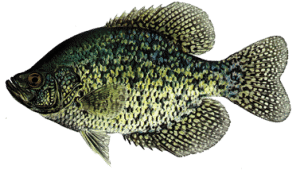Characteristics

The way you fish for Crappies and the equipment you use to catch them is simple and inexpensive.
They are found in a variety of waters including natural and man-made lakes, reservoirs and small ponds. Although they prefer standing water, the are also found in moderate to large streams and rivers.
They are always biting, so you’re sure to catch one every time you cast your line. Urban legend says that when the Mayfly hatches, this fish becomes more aggressive in eating. If you catch one you are likely to catch more in the same area because they travel together in schools. They feed on small fish and water insects.
They can weigh up to 2 pounds and reach up to 10 inches. Most of this species caught are the Black Crappies. This species, unlike Bluegills, prefer colder, deeper clear water.
Black Crappies are dark and have black spots on their scales. They also have about seven spines on the topside of their body, known as its dorsal fin.
There are White or Black ones but in this north central region the Black ones are more common. The White ones have a vertical bar marking and about five dorsal spins.
They are great eating fish. They produce sweet filets. Most people practice Catch N Release, however, there are those who catch them to eat.
The DNR is always working on the protection of fish habitat and maintaining a good balance of fish and lake environment in an effort to keep fish well for anglers.
Habitat
These pan fish school together so if you find one fish, you’ll definitely find more. If you find large fish in the water, odds are you won’t find Crappies in the same area because they tend to stay away from the larger fish that eat them.
They swim in large schools and prefer fairly warm weather but like to say in deeper water than Bluegills. You could usually find this species in all types of covers, i.e., under driftwood, by tree stumps, etc.
They spawn in colder deeper water – approx. 6 feet deep in late spring early summer. The male builds the spawning bed. After the female lays their eggs the male will fertilize the eggs and protect the bed. This species when in natural lakes are most vulnerable during the spring spawning period.
They learn to move near underwater structures during the summer. Timber provides shade, cover and food making it an excellent place to catch them.
Equipment
Almost any type of fishing equipment can be used to catch this pan fish. The lighter the equipment the more fun it will be to catch the fish. Use ultra-light spinning or casting rods and light-weight reels as well as 4 pound-test line (not exceeding 6 pound-test line) and small to large size bobbers.
Most artificial lures for catching this type of fish are the leadhead jig, which imitates a small minnow. You can find an assortment of colors and sizes. The most popular leadheads seem to be either a feathered or plastic white or yellow bodied one.
Small hooks are recommended when you fish for this type of fish. They can be fished with or without a bobber. A bobberless jig will give you the ability to try fishing in different depths. Regardless of whether or not you use a bobber, jigs should always be fished in atleast a foot off the bottom of the lake.
Since they are smaller fish, you won’t need heavy equipment like you would for larger more aggressive fish.
Small minnows are by far the best live bait to use for catching this fish. Most bait shops carry several sizes of minnows. A minnow can measure from 1 to 1 ½ inches in length, which is the size that should be used.
Hook a minnow through the back of the tail. This will allow the minnow to swim freely and live longer.
Tips for Fishing
You can sit on a pier, hangout on the shoreline or wade off a boat when you fish for this species. Since these are passive fish, compared to other fish, you’ll have a relaxing time fishing for them. So if you want to have a quite time fishing, this may be the fish for you.

